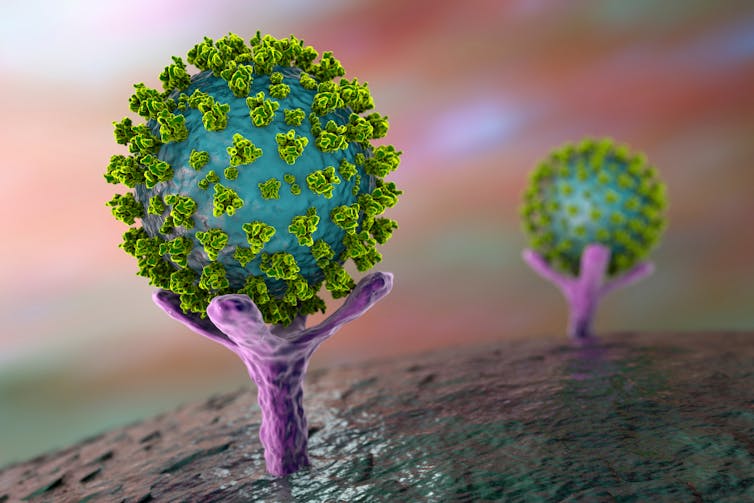Source: The Conversation (Au and NZ) – By Lara Herrero, Research Leader in Virology and Infectious Disease, Griffith University
Last week we heard Queensland-based biotech company Microbio had developed a test that could, according to media reports, tell whether someone is a COVID-19 superspreader.
While this may sound like an exciting prospect, there are a few questions to answer before we know what role this test might have in managing the spread of COVID-19.
First, what is a superspreader?
It’s important to understand there’s no scientific definition of a “superspreader”.
In the context of COVID-19, the term “superspreader” has been used to describe someone who can spread the virus and cause infection in many people with minimal contact.
There are many factors thought to contribute to what makes someone a superspreader. The most talked about is infectious viral load. Put simply, this is the amount of live infectious virus a person carries.Current thinking is that people with a higher infectious viral load are more likely to infect others, but it may not be that simple.

When a person has a COVID-19 test, the health-care worker uses a swab to collect samples from the back of the person’s nose and throat. These are the areas where the virus likes to live. The swab is then sent to a pathology lab which tests for the presence of viral genomic material.
The test returns as a positive (that is, the virus has been detected) or negative (virus not detected). There’s no indication of how much virus is present, or whether it’s replicating.
Read more: Coronavirus: superspreading events could help make COVID-19 endemic
So, back to the new test
Microbio says the newly developed InfectID-COVID-19-R test can detect “replication-competent virus”. This essentially means the test would detect the amount of active live virus a person is carrying. Researchers believe the patient is most likely to be infectious when the virus is replicating.
Like current COVID-19 tests, the test requires a sample of viral genetic material from a patient swab. The genetic material is “extracted” from the swab (termed RNA extraction). The resulting sample is put through a machine to detect an important part of the virus genome which indicates whether the virus is alive and replicating.
InfectID-COVID-19-R claims to accurately detect a virus concentration as low as 1,500 TCID50 per millilitre with 99% specificity. (TCID50 stands for tissue culture infectious dose 50% — it’s currently the accepted standard to quantify the amount of infectious SARS-CoV-2.)
This equation may be tricky to grasp, but the important part to understand is that below this threshold, the person has a lower amount of replicating virus than the test can guarantee to detect. They can’t say for certain the person has no replicating virus.
If a person records a result above the threshold, that tells scientists the virus is alive and replicating.
The suggestion is the test will be able to quantify the amount of replicating virus present in the swab. But exactly what that means — and how the test will achieve this — is uncertain.
Read more: A few superspreaders transmit the majority of coronavirus cases
Microbio’s media release is tight-lipped on a few key aspects of this test. We still don’t have answers to some questions, including:
-
what part of the virus genome it is detecting, and how is this different to our current diagnostic tests?
-
how does detecting this part of the virus ensure detection of replicating or “live” virus?
-
how will the test results be presented? For example, will the test provide a reference range and guide on how to interpret the result?
-
how can they prove that if a test comes back below the limit of detection for replicating virus that the person is not infectious?
In response to queries from The Conversation, Microbio’s chief scientific officer Flavia Huygens said the new test “targets the part of the virus’ genome that is present while it is replicating inside the human cell”, and that this target is different to existing COVID-19 tests. She added: “Our test detects the portion of the virus genome that is only present whilst the virus is replicating and hence is indicative that the virus is “live.”
Huygens also said the test has built-in references and guides for clinical laboratories to interpret the results.
It’s early days yet
Without more detail, it’s too early to tell just how useful this test will be.
Certainly, we need to know whether a low replicating viral load means a person is not infectious before using this test to make any decisions around quarantine. Research is still ongoing in this area.

The test hasn’t yet been approved for use. It has been independently validated by 360 biolabs, a clinical trial laboratory accredited by the Australian National Association of Testing Authorities. Huygens told The Conversation that Microbio is planning further validation of its test using patient samples.
More than a question of viral load
Currently we have no way to know who may be a superspreader. While this test might give us a measure of a person’s replicating viral load, this is only one piece of the puzzle.
As is the case for any virus, spreading SARS-CoV-2 requires more than just high viral load. It requires the right environmental conditions (for example, indoors and lower humidity), proximity to an infected person, and time (more time exposed means more chance of infection).
Therefore it’s more accurate to refer to “superspreading events” rather than to particular people as “superspreaders” more generally. Superspreading events are situations in which one person, aided by the ideal conditions, infects a large number of others.
With this in mind, limiting the time you spend in confined spaces (and wearing a mask if you can’t avoid a closed space), washing your hands and keeping your distance will be your best protection against COVID-19.
Read more: Why do some COVID-19 tests come back with a ‘weak positive’, and why does it matter?
– ref. Could a test really detect if someone is a COVID-19 ‘superspreader’? – https://theconversation.com/could-a-test-really-detect-if-someone-is-a-covid-19-superspreader-148627







